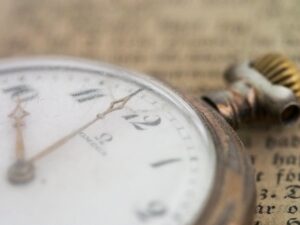Chasing Accuracy
Have you ever wondered why your expensive new mechanical watch seems to be slightly off every time you check it against the atomic clock app on your smartphone? You dropped more than $3,000 on this beauty and yet the 30 no-name quartz watch you bought five years ago at Target seems to keep more accurate time. Your watch suffers from clock drift, a phenomenon that plagues all clocks and watches, some more than others.

(Pixabay / Free-Photos)
Nobody’s Perfect
First, the good news. No watch is 100% accurate, not even the most accurate clock on earth, the atomic clock. When the first mechanical clocks came onto the scene in Europe in the 1300s, they were said to be accurate only within 15 minutes. Later in the 1600s, Christiaan Huygens, a famous mathematician, astrologer, physicist, and horologist, invented the pendulum clock, dramatically reducing clock drift from 15 minutes a day to 10-15 seconds a day. The “quartz revolution,” also known as the “quartz crisis,” in the 1970s again reduced time loss to +1/-1 seconds per day. Suddenly, mechanical watchmakers were forced into the background as the battery-operated, mass-produced, and more accurate quartz watches took center stage.
Traditional Swiss watchmakers, though, were not about to allow the advent of quartz technology to spell the end of the mechanical watch. If anything, quartz engineering set craftsmen on a course to create the most accurate timepieces possible using traditional mechanical systems. Rolex, for example, innovated beyond the rigorous COSC (the Official Swiss Chronometer Testing Institute) Chronometer certification of -4/+6 seconds per day to achieve an accuracy rating of +2/-2 seconds per day, bringing it closer than ever to its quartz competitors. As of today, though, the atomic clock remains the most accurate timepiece we’ll have for the foreseeable future. Clock drift on atomic clocks is one second lost for every 100 million years.
Mechanical vs. Quartz
One of the key reasons why quartz watches are inherently more accurate time-keepers than their mechanical counterparts is frequency stability. In a quartz watch, the battery sends an electric charge through the crystal, which then vibrates or oscillates at a stable frequency to run a tiny watch motor that powers the watch functions. A mechanical watch, on the other hand, derives its energy to run the watch from winding or, in automatic watches, the kinetic energy produced by the wearer’s wrist and hand movements. There are also significantly more moving parts – anywhere from 130 to more than a 1000 – in a mechanical watch, constantly causing friction and energy loss. No matter how many times you wind that watch, you’ll still end up losing some of that energy you just produced, and that affects your watch’s oscillation frequency. The inner workings of a mechanical watch are also dependent on a number of external variables, such as temperature, gravity, shock, and magnetism. In contrast, the quartz’s stable frequency is not as affected by those real-world conditions.
Keep Your Watch Running on Prime Time
Now that you know some clock drift is inevitable, you can be assured you got the value and quality you paid for when you emptied out your kid’s college fund. Since mechanical watch systems are so sensitive to external conditions, we have included some tips below to keep your expensive piece of wristwear functioning at optimal accuracy between watch repairs and tune-ups.
- Avoid extreme temperatures (under 41℉ and over 95℉). All those tiny parts inside your watch are made of metal, which expands and contracts with changes in temperature. Too hot and you are likely to lose time. Too cold and you’ll gain time. Either way, your accuracy will be compromised.
- Steer clear of magnetic fields. Magnetic objects like cell phones, TVs, PC speakers, magnetic clasps and handles, and hair dryers are just a few things that can foul up your watch’s timing. Hint: When you get your brand-new watch stand, don’t place it next to the magnetic picture frame.
- Be aware of gravity and the ways it affects the inside movements of your watch. Where you wear the watch (on a mountaintop or in space), when and how you wear it, and even the way you store your watch when you’re not wearing it can affect its accuracy.
- Shock is bad. Let me say this again – shock is bad! Consider taking off your watch before exercising or engaging in any activity where there could be a significant amount of shock or trauma to your watch. Let’s face it – shock and trauma rarely produce desirable results in anything, except maybe explosions.
Unlike quartz watches, your mechanical watch will last centuries and still keep excellent time as long as you take good care of it. Whether you spent $500 or $5,000 on your mechanical timepiece, consider it an investment worth the same protection you’d give a vehicle or piece of art.
In addition to the tips above, be sure to bring your watch in or send it to a watch repair shop regularly, usually once every three years. Our Swiss-trained master technicians are well-versed on mechanical and quartz watch repair and the inner workings of more than 100 watches and clocks, including Rolex, Seiko, Omega, Timex, Tissot, Breitling, and Cartier.

